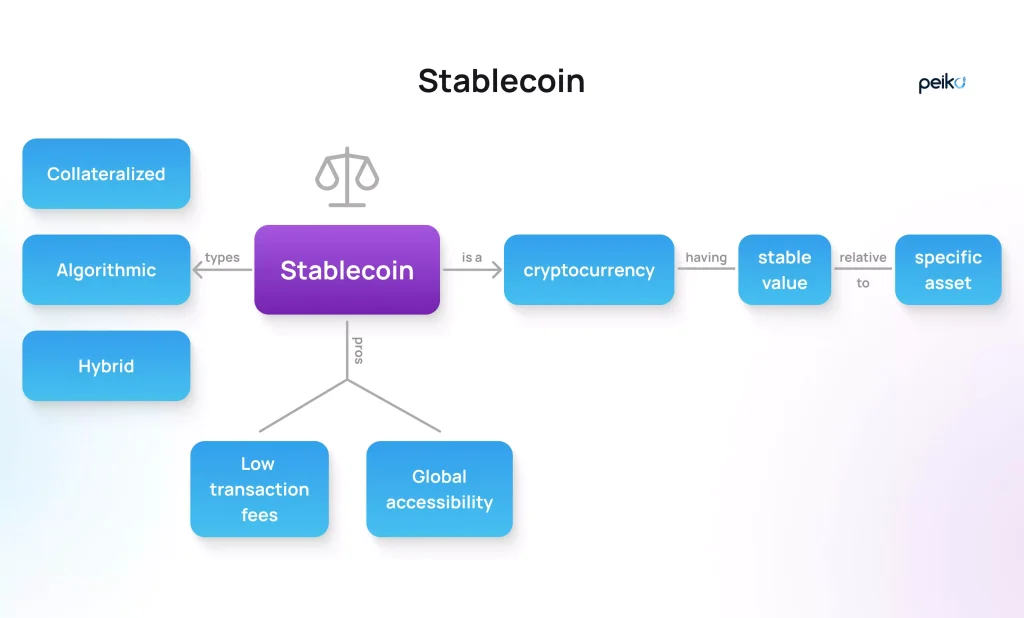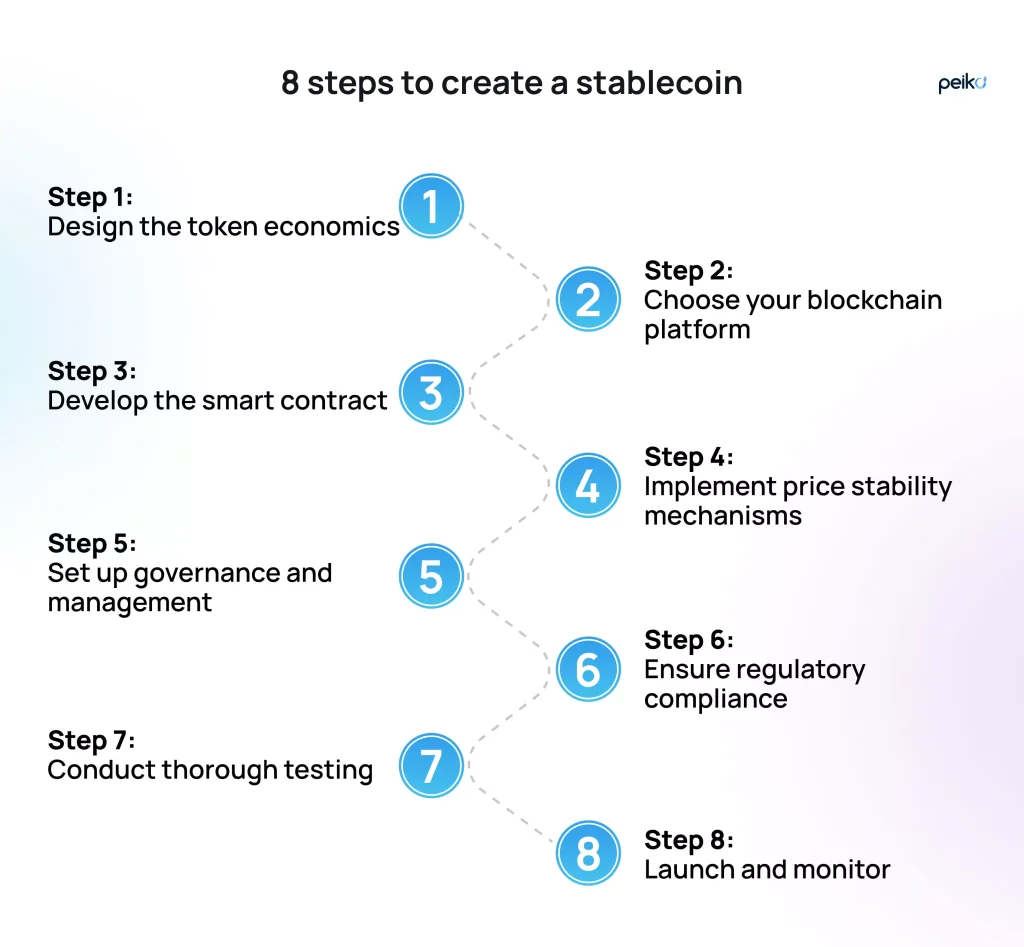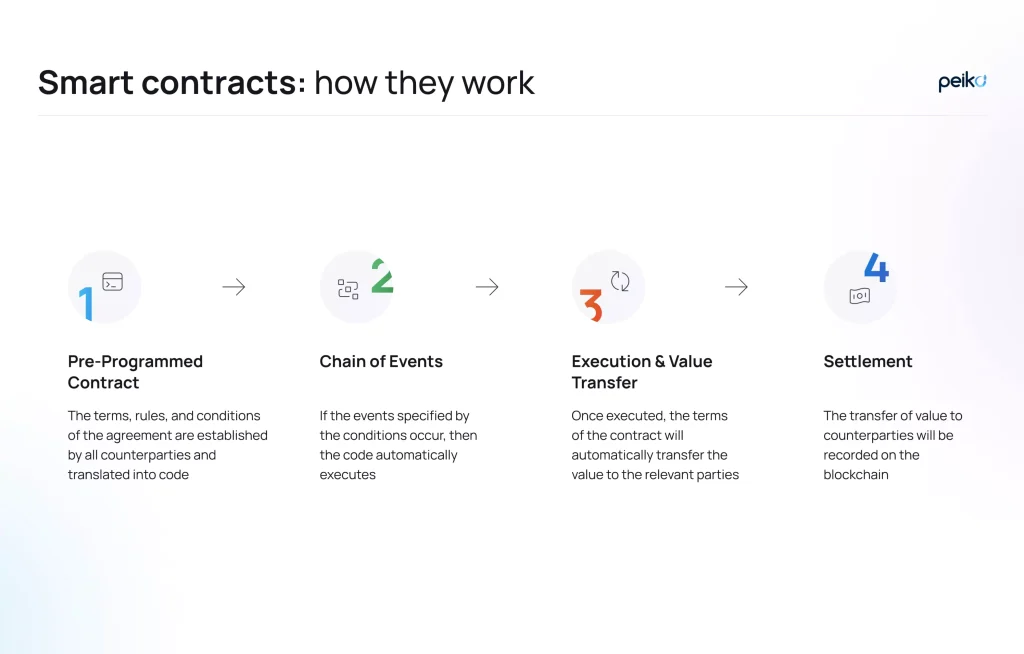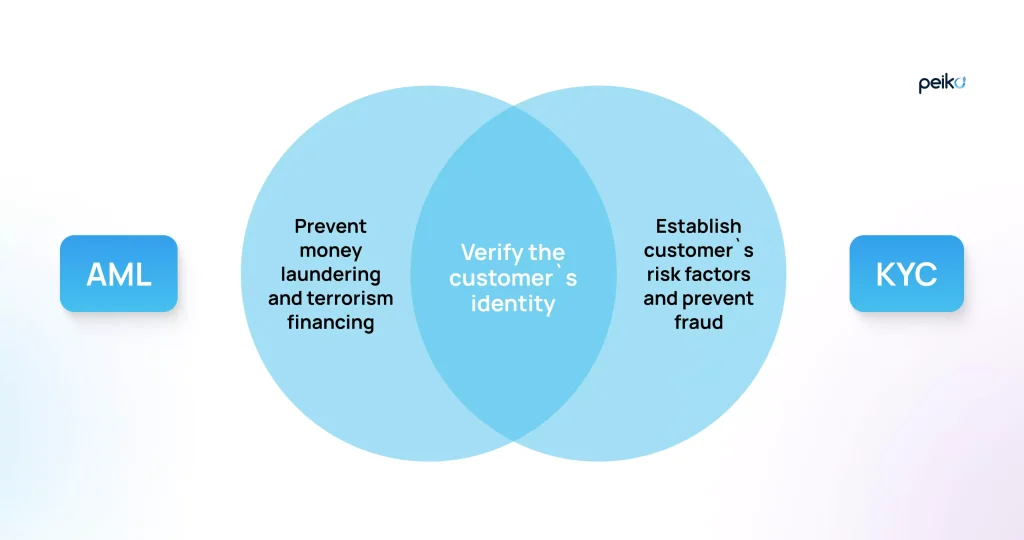How to Create a Stablecoin: A Step-by-Step Guide
What is a digital currency that merges the swift, cutting-edge nature of cryptocurrencies with the dependable stability of traditional money? That’s the essence of stablecoins—innovative digital assets designed to keep their value steady by anchoring to a reserve or using advanced algorithms.
If you aim to build a groundbreaking financial tool or are a crypto enthusiast eager to dive into blockchain innovation, developing a stablecoin offers great business opportunities. So, how to create a stablecoin?
In this guide, we will consider the main steps to crafting a stablecoin: defining how your stablecoin will maintain its value, building and launching it on a blockchain, ensuring it meets regulatory standards, and testing it for optimal performance.
Let’s discover all the details on how to create a stable coin!
Stablecoin and its main types
Let’s start with the definition. So, whats a stablecoin? A stablecoin is a cryptocurrency designed to maintain its value by linking it to another coin, asset, or financial instrument. Unlike traditional cryptocurrencies, which often experience significant volatility and are less suited for everyday transactions, stablecoins are designed to provide a reliable and stable alternative. This stability and reliability are crucial for many fields, including trade finance, banking, charity, and others, where precise and reliable currency values are essential for transaction accuracy.
How do stablecoins work? To uphold the stable value, the organization behind the stablecoin keeps a reserve of the pegged asset. Certain stablecoins use algorithmic methods to maintain their peg.
If you are looking at how to create your own stablecoin, it is vital to know the main categories of stablecoins to choose the right one for your business project.

Collateralized stablecoins
Such stablecoins derive their value from specific assets held in reserve. They are divided into:
- Fiat-backed stablecoins: These stablecoins are tied to the value of conventional currencies. Tether (USDT) was the first of its kind, pegged to the US dollar and supported by reserves that match its market cap. Other examples include USD Coin and PAXOS Standard.
- Asset-backed stablecoins: They are secured by physical assets such as gold, silver, diamonds, oil, or real estate rather than by fiat or other cryptocurrencies.
- Crypto-backed stablecoins: These coins are supported by other cryptocurrencies but use mechanisms to stabilize their value. For instance, DAI is a crypto-backed stablecoin that is tied to the US dollar and backed by Ether. It maintains stability through MakerDAO’s smart contract, which adjusts the supply of MKR tokens in response to changes in the value of Ether.
Algorithmic stablecoins
These stablecoins might hold reserve assets, but their primary method of maintaining price stability is through algorithm-driven supply adjustments. This involves using a programmed formula to regulate the coin’s supply dynamically.
This approach is somewhat analogous to the role of central banks, which stabilize currency value without relying solely on reserve assets. For example, central banks like the U.S. Federal Reserve publicly announce monetary policies based on clear parameters, adding credibility because they are the official issuers of legal tender.
Hybrid stablecoins
These stablecoins integrate aspects of both collateralized and algorithmic stability models. They usually maintain their value by combining reserve assets with algorithm-driven supply adjustments. For instance, a hybrid stablecoin might be secured by a mix of fiat and cryptocurrency assets while also using algorithms to manage its supply dynamically. This approach aims to harness the benefits of both asset-backed security and flexible, algorithmic regulation, striving for a more balanced and resilient stability.
How to choose the type of stablecoin for your project
When selecting a stablecoin for your project, keep these factors in mind:
- Objective: To create your own stablecoin, you should align your choice with your project’s goals. Fiat-backed stablecoins work well for stable transactions, while asset-backed or crypto-backed options may be better suited for trading or investment.
- Backing assets: Evaluate the assets you can use. Fiat-backed stablecoins need cash reserves, asset-backed ones require physical assets, and crypto-backed stablecoins rely on cryptocurrencies and smart contracts.
- Regulatory considerations: Make sure the stablecoin type complies with the regulatory considerations of your target markets.
- Value stability: Determine if you need a stablecoin that uses algorithmic adjustments for flexibility or a hybrid model that combines collateral with algorithms for enhanced stability.
- Resources: Consider your available technical and financial resources. Fiat-backed stablecoins often demand more infrastructure compared to algorithmic or hybrid types.
Now, we will explain the main stages we follow at Peiko to provide top-notch stablecoin development services.
Steps to follow to create your own stablecoin
In this section, we will consider the fundamental steps needed to create a stablecoin. The Peiko team will help you build a stable, functional, and compliant digital currency.

Step 1: Design the token economics
The initial phase of our stablecoin development services involves crafting a comprehensive token economics strategy. This is essential for ensuring your stablecoin maintains value stability and operates effectively. Here’s how to approach this step:
Determine supply and demand mechanics
Establish the mechanisms by which your stablecoin will balance demand and supply to maintain a stable value. It is essential to develop a model outlining how the token supply will be adjusted based on market fluctuations. This could involve algorithms or predefined rules for issuing or burning tokens in response to changes in demand, ensuring the stablecoin’s price remains stable.
Set up collateralization (if applicable)
If your stablecoin relies on collateral, decide on the nature and amount of assets needed to back it.
For fiat-backed stablecoins, this means defining how much fiat currency will be held in reserve to support the token’s value. For asset-backed stablecoins, identify the physical assets (such as gold, silver, or real estate) and establish methods for their valuation and management. For crypto-backed stablecoins, specify the cryptocurrencies that will serve as collateral and implement mechanisms (such as smart contracts) to adjust collateral levels according to price fluctuations.
At Peiko, we offer comprehensive blockchain development services and can assist you in designing tokenomics, and other planning aspects before starting the development process.
Step 2: Choose your blockchain platform
After deciding on the type of stablecoin you want to create, the next step is choosing the right platform for stablecoin development. Initially, Ethereum was the primary choice for stablecoin creation, but the landscape has expanded significantly.
While Ethereum dominated the stablecoin market up until 2018, newer blockchain platforms have since emerged. Tron, Binance Smart Chain, and EOS have become popular alternatives. In 2019, a surge of stablecoin projects, including Carbon (CUSD), Tether, EUSD, and EOSDT, were launched on EOS due to its advantages, such as:
- Enhanced interoperability
- High scalability and transaction throughput
Weighing the benefits and drawbacks of each platform will help you make an informed decision on which to use. Once you’ve selected the platform and technology, the next crucial step to create your own stablecoin involves ensuring adequate liquidity maintenance.
Considerations for scalability and fees
When assessing potential platforms, it’s important to examine their scalability and transaction fees. Ensure that the platform can efficiently manage the transaction volume your stablecoin will generate, as high scalability is vital for maintaining performance and reliability as user activity increases. Also, you should evaluate the transaction costs. Lower fees can decrease operational expenses and enhance cost-effectiveness for users.
Step 3: Develop the smart contract
Developing the smart contract is a crucial stage in your stablecoin project, as it dictates how the stablecoin will operate on the blockchain and ensures its security.

In your smart contract, be sure to incorporate these essential elements:
- Minting and burning functions: Set up mechanisms for minting new tokens and burning existing ones to adjust the supply based on market needs or user actions. This feature helps maintain the stablecoin’s intended value stability.
- Collateral management: For collateral-backed stablecoins, the contract should manage collateral deposits and withdrawals, ensuring that the backing assets are adequate to support the issued tokens. It should also handle automatic adjustments to keep collateral levels in check.
- Redemption and conversion: Include functionality for users to redeem stablecoins for the underlying asset or currency at a set rate, with fees applied. This ensures easy exchangeability without disrupting market stability.
- Governance and upgrades: Build in governance features and upgrade protocols. This might involve systems for proposing and voting on changes to the smart contract, allowing for future modifications as needed.
At Peiko, we place a strong emphasis on safeguarding the security of your smart contract to prevent vulnerabilities. Our process involves meticulous auditing of the contract code to identify and resolve potential security concerns prior to its deployment.
Our team conducts comprehensive testing in a controlled environment, replicating real-world scenarios and stress conditions. This thorough approach helps reveal any issues and ensures that the contract functions reliably across a range of situations.
Moreover, we implement fail-safes and recovery mechanisms to handle unexpected problems. Features like emergency pauses or rollback functions can help revert to a stable state if needed.
By integrating the essential features into smart contracts and addressing security concerns, you will create a secure and effective smart contract that supports the stable and reliable operation of your stablecoin.
Step 4: Implement price stability mechanisms
To ensure that your stablecoin maintains a consistent value, it is vital to deploy effective price stability mechanisms. These mechanisms help keep the stablecoin’s value steady in relation to its target asset or currency.
Pegging methods
These are techniques used to link the value of your stablecoin to a specific asset or currency. Several approaches include:
- Fiat pegging: This approach links the stablecoin’s value to a conventional fiat currency, such as the US dollar. It generally involves maintaining a reserve of the fiat currency equivalent to the total value of the stablecoins in circulation. For example, a USD-pegged stablecoin strives to keep a 1:1 value ratio by holding an equivalent amount of US dollars in reserve.
- Commodity pegging: Here, the stablecoin’s value is linked to physical commodities such as gold, silver, or oil. The stablecoin’s value aligns with the price of the commodity, necessitating the maintenance of reserves in the form of the commodity or its equivalent value.
- Crypto pegging: This involves anchoring the stablecoin’s value to other cryptocurrencies. It may use a basket of cryptocurrencies or a specific asset like Bitcoin or Ethereum. Stability is managed through smart contracts and collateral management techniques.
Rebalancing strategies
Without effective rebalancing, your stablecoin could face significant deviations from its intended value, resulting in potential user losses and a decline in credibility. Below are the main rebalancing strategies that can help to maintain value stability:
- Automated supply adjustments: Implement algorithms that automatically modify the stablecoin’s supply based on its market price compared to the pegged value. For instance, if the stablecoin’s price exceeds its target, the system might issue more tokens to increase supply and bring the price down. Conversely, if the price drops below the target, tokens may be burned to reduce supply.
- Collateral management: For collateral-backed stablecoins, set up systems to manage and adjust collateral levels. This involves recalibrating the collateral to match the amount of tokens in circulation, ensuring that the value remains aligned with the peg.
- Market interventions: Engage in market operations, such as purchasing or selling the stablecoin on exchanges, to help stabilize its price. By actively participating in the market, you can mitigate price fluctuations and ensure the stablecoin remains close to its target value.
Effective implementation of these pegging methods and rebalancing strategies is essential for maintaining the stability and effectiveness of your stablecoin, ensuring it reliably serves its intended purpose.
Step 5: Set up governance and management
Creating a solid governance and management framework is essential for the ongoing success and adaptability of your stablecoin.
Creating a DAO (if applicable)
A decentralized autonomous organization (DAO) is a governance system built on blockchain technology that automates decision-making using smart contracts. This model enables decentralized management and transparency.
To create a DAO for your stablecoin, begin by issuing governance tokens that empower holders to participate in decision-making processes. These tokens allow stakeholders to propose and vote on key changes, such as updates or policy modifications, ensuring collective control over the stablecoin development process.
Integrate voting systems into the DAO to handle proposal submissions and decision-making. Smart contracts will streamline these processes, ensuring that votes are accurately counted and decisions are automatically implemented based on established rules.
Encourage active participation by offering incentives, such as rewards or additional tokens, to contributors. Staking mechanisms can also be introduced to align stakeholders’ interests with the stablecoin’s long-term success. Ensure that the DAO’s smart contracts are robust and thoroughly audited to safeguard against vulnerabilities.
Determining roles and responsibilities
Clearly defining roles and responsibilities is essential for effective governance and management:
- Operational oversight: Assign individuals to manage daily tasks such as transaction processing, user support, and liquidity. Define who will handle system maintenance and operational issues.
- Tech supervision: Designate teams or individuals for technical tasks, including smart contract development, updates, and security.
- Compliance and risk management: Appoint roles focused on regulatory compliance and risk management. These roles should monitor legal changes, conduct risk assessments, and address compliance and security concerns.Community engagement: Create roles to interact with the community and gather feedback. These positions help maintain transparency, address user concerns, and strengthen the connection between governance and users.
Establishing a clear governance model, whether through a DAO or conventional methods and defining roles effectively provides a strong foundation for managing and adapting your stablecoin.
Step 6: Ensure regulatory compliance
Maintaining regulatory compliance is vital for your stablecoin’s success and reputation. Start by familiarizing yourself with the specific regulations governing your stablecoin, including registration, reporting obligations, and financial oversight.
Turn to legal professionals to navigate these requirements and embed compliance measures into your stablecoin’s operations. Continuously update your practices to align with changing regulations and ensure transparency with regulatory authorities. This proactive approach minimizes legal risks, and fosters trust among users and regulators, ensuring the stablecoin’s long-term viability and integrity.
Implement KYC (know your customer) and AML (anti-money laundering) protocols to ensure robust security and legal adherence. This includes checking user identities and monitoring transactions to detect and prevent illicit activities.

Step 7: Conduct thorough testing
Testing is critical to create your own stablecoin that operates as intended and remains robust in different scenarios.
Smart contract audits
Perform a comprehensive audit of your smart contracts to uncover and address any potential vulnerabilities or errors. It’s advisable to work with established third-party auditing firms to scrutinize your code for security issues, inefficiencies, or bugs. This rigorous review process helps guarantee that your smart contracts are secure and function correctly, reducing the risk of exploits or operational failures.
Simulating various market conditions
Evaluate your stablecoin’s performance by simulating a variety of market conditions. Test it under scenarios like high market volatility, sudden crashes, or spikes in transaction volume to see how well it maintains its value and stability. This testing helps identify any weaknesses and allows you to fine-tune your stability mechanisms, ensuring that your stablecoin remains reliable in diverse real-world situations.
Step 8: Launch and monitor
The Peiko team will help you implement a strategic launch plan for your stablecoin and offer vigilant monitoring and timely adjustments.
We will develop a comprehensive plan for the initial distribution of your stablecoin. Then it is vital to determine how to allocate and distribute the stablecoin, which could involve partnerships, promotional airdrops, or initial token sales. A transparent and well-executed distribution strategy is key to establishing liquidity and encouraging early adoption, laying a strong foundation for your stablecoin’s market presence.
Once your stablecoin is live, keep a close watch on its performance to ensure it functions as intended and maintains stability. Regularly monitor transaction volumes, market fluctuations, and any changes in regulatory requirements. At Peiko, we can make necessary adjustments as needed, such as refining smart contracts, modifying collateralization parameters, or adapting to market dynamics.
Ongoing maintenance and timely updates are essential to address any emerging issues and ensure your stablecoin remains reliable and effective over time.
Bonus: a helpful video about creating a stablecoin
To complement our comprehensive guide on developing a stablecoin, we’ve added a detailed video that visually breaks down the process. Watch this video to gain a deeper perspective and practical knowledge that will support your journey to launch a successful stablecoin.
Peiko’s expertise in blockchain development
When it comes to stablecoin development, Peiko stands out for its deep expertise in blockchain technology and innovative solutions. We have vast experience in crafting secure and scalable blockchain applications. We know how to start a crypto exchange or crypto wallet startup and can help you create robust stablecoins tailored to your needs.
One of our best blockchain projects is Vorpal. It is an efficient and robust decentralized exchange leveraging the Binance Smart Chain. By forking PancakeSwap, we enhanced the platform’s efficiency and laid a strong foundation for future advancements. We also integrated Binance Coin (BNB) to capitalize on Binance’s ecosystem advantages, boosting the DEX’s performance and compatibility.
Our efforts included creating sophisticated functionalities like token swapping, farming, and staking, alongside integrating Web3 wallets for seamless user interactions. We ensured accurate calculation of cryptocurrency earnings and optimized smart contracts for security and efficiency.
The outcome is a robust, user-centric DEX that redefines trading and investment experiences with its comprehensive feature set and enhanced functionality.

By the way, on our blog, you can read many interesting articles on the topic of blockchain in energy market, what are Telegram Mini Apps, and more.
Conclusion
In the cryptocurrency field, the primary goal has often been to develop a digital asset that is both stable and highly liquid. Stablecoins are seen as the ultimate achievement in this quest, enabling seamless transactions between parties dealing with cryptocurrencies and those needing to convert between crypto and fiat currencies. To build an effective solution, it is better to turn to an experienced stablecoin development company.
At Peiko, we can help you develop a blockchain product for any complexity, including stablecoin. Contact us today and receive a top-tier blockchain project that will drive revenue.










